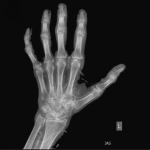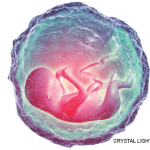We presented this case to highlight the importance of vigilance on supposed RA patients’ refractory to synthetic disease-modifying anti-rheumatic drugs (sDMARDs), especially if they are seronegative and anchored on subjective complaints. Those cases should alert the physician to a possible RA mimicker, even in the presence of hand deformities.
In the absence of a perfect molecular disease activity marker, clinical acumen remains critical for dissecting patients’ complaints about pain and guiding treatment. Because pain is an abstract symptom, physicians must be aware of its different domains. Dr. Carlos Antonio Moura (one of the authors), tells his fellows that every time an RA patient seems to be failing a treatment regimen they should apply the mnemonic PAIN (see Table 1) to help them separate causes of pain and also to help them remember possible mimics and confounders of RA. Although it’s common for patients in the rheumatologist’s
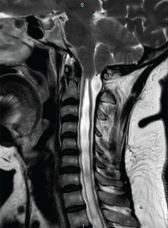
Figure 7: An MRI of the patient’s spine and head confirmed an extensive syringomyelia secondary to Chiari type I malformation.
office to present with an overlap of those different pain domains, it’s our job to dismantle them and find the best treatment strategies to avoid iatrogenic occurrences.
Other hand deformities may mimic RA as well, including nerve injuries (e.g., claw hand syndrome), mutilating psoriatic arthritis, erosive osteoarthritis, hemochromatosis (i.e., the so-called iron salute), Jaccoud arthropathy, calcium pyrophosphate deposition disease, tophaceous gout, multicentric reticulohistiocytosis and diabetic cheiroarthropathy.2
Bottom line: We think rheumatologists should know these conditions as well as they know RA.
Final Thoughts
Our case report illustrates a patient misdiagnosed with seronegative RA because of symmetric hand pain associated with atypical deformities. The presence of benediction hands plus Charcot arthropathy of shoulders and dissociated sensory loss on the upper extremities suggested a neuropathic origin of the disease, leading to the diagnosis of syringomyelia.
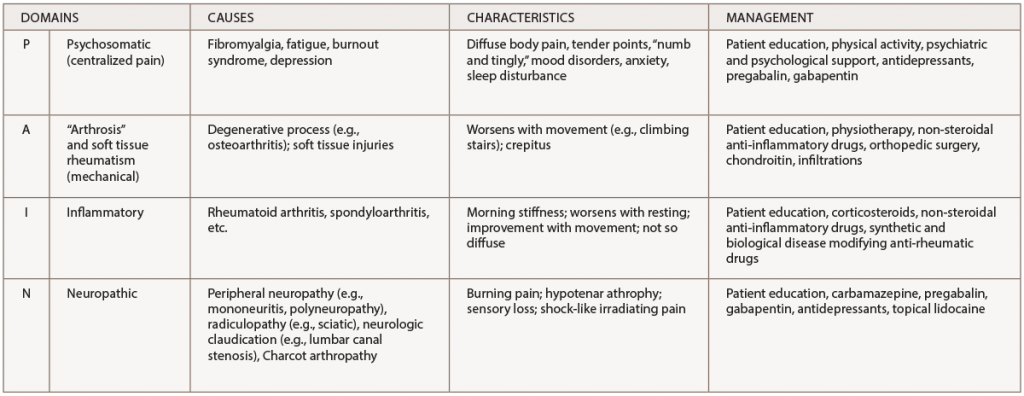
(click for larger image) Table 1: A Practical Approach to Pain Domains*
* It is not uncommon for patients in the rheumatologist’s office to present several of these pain areas concomitantly. It is our job to dismantle them to guide the best treatment decisions.
We hope this report helps other physicians remember that not all cases of symmetric hand pain and deformities are RA, especially when ACPA and RF are negative and the patient is refractory to first-line therapies.
 Carlos Antonio Moura, MD, is a rheumatologist and the preceptor of the internal medicine residency program at Hospital Santo Antônio in Salvador, Bahia, Brazil, and teaches at Salvador University and Escola Bahiana de Medicina e Saúde Pública.
Carlos Antonio Moura, MD, is a rheumatologist and the preceptor of the internal medicine residency program at Hospital Santo Antônio in Salvador, Bahia, Brazil, and teaches at Salvador University and Escola Bahiana de Medicina e Saúde Pública.
 Nathalia Crusoé, MD, is a resident in internal medicine at Hospital Santo Antônio in Salvador, Bahia, Brazil.
Nathalia Crusoé, MD, is a resident in internal medicine at Hospital Santo Antônio in Salvador, Bahia, Brazil.
 Marília Cruz, MD, is a resident in internal medicine at Hospital Santo Antônio in Salvador, Bahia, Brazil.
Marília Cruz, MD, is a resident in internal medicine at Hospital Santo Antônio in Salvador, Bahia, Brazil.
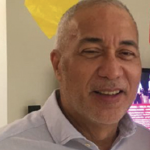 Carlos Geraldo Moura, MD, is a rheumatologist and chief of the internal medicine residency program at Hospital Santo Antônio in Salvador, Bahia, Brazil, and teaches at Escola Bahiana de Medicina e Saúde Pública.
Carlos Geraldo Moura, MD, is a rheumatologist and chief of the internal medicine residency program at Hospital Santo Antônio in Salvador, Bahia, Brazil, and teaches at Escola Bahiana de Medicina e Saúde Pública.
References
- Mjaavatten MD, Bykerk VP. Early rheumatoid arthritis: The performance of the 2010 ACR/EULA criteria for diagnosing RA. Best Pract Res Clin Rheumatol. 2013 Aug;27(4):451–466.
- Lans J, Machol JA 4th, Deml C, et al. Nonrheumatoid arthritis of the hand. J Hand Surg Am. 2018 Jan;43(1):61–67.
- Neves, Fde S, Gonçalves DP, Gonçalves CR. Syringomyelia, neuropathic arthropathy and rheumatoid arthritis as diagnostic dilemmas in two different cases: confounding factor and true coexistence. Clin Rheumatol. 2007 Jan;26(1):98–100.
- Grear BJ, Rabinovich A, Brodsky, JW. Charcot arthropathy of the foot and ankle associated with rheumatoid arthritis. Foot Ankle Int. 2013 Nov;34(11):1541–1547.
- DeQuattro K, Imboden JB. Neurologic manifestations of rheumatoid arthritis. Rheum Dis Clin North Am. 2017 Nov;43(4):561–571.
- Bhattacharyya S, Helfgott SM. Neurologic complications of systemic lupus erythematosus, Sjögren Syndrome, and rheumatoid arthritis. Semin Neurol. 2014 Sep;34(4):425–436.
